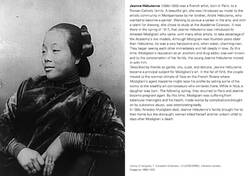(English translation below)
Mathilde ter Heijnes „Women to go" sind Frauen zum Mitnehmen. Si findet das ziemlich ironisch. Hör dir an, warum:
„Wenn du aus dem Ausstellungsraum von dem berühmten Gerhard Richter kommst, könntest du diesen Postkartenständer direkt vor der Tür leicht übersehen. Das wäre wirklich schade - nicht nur, weil du die Chance verpasst hast, ein paar kostenlose Souvenirs vom Albertinum nach Hause mitzunehmen - sondern, weil du eines der aus meiner Sicht klügsten Werke von der ganzen Sammlung im Albertinum verpasst.
Wenn du eine Postkarte in die Hand nimmst (Ja, du darfst!) und umdrehst, liest du einen Text über eine berühmte Frau. Dies ist natürlich die Präsentation der Frau auf dem Foto - so dachte ich, bis ich zwei Namen von chinesischen Frauen gesehen habe. Allerdings waren die Bilder auf der anderen Seite weiße Frauen. Mir wurde klar, dass die beiden Seiten der Postkarten nicht zusammengehören. Einerseits haben die Frauen auf den Porträts auf der Vorderseite ihre Namen verloren, andererseits werden die historisch einflussreichen Frauen auf der Rückseite zu körperlosen Schriftstücken. Bedeutet das, dass der historische Beitrag von Frauen immer hinter ihrem überbewerten Aussehen versteckt ist?"
------------------------------------------------------------------
Mathilde ter Heijne's 'Women to Go' features women who are available to take along with you. She finds this quite ironic. Listen to why she feels this way:
'When you come out of the exhibition room featuring the famous Gerhard Richter, you might easily overlook the postcard stand right in front of the door. That would be a real shame—not just because you'd miss the chance to take home some free souvenirs from the Albertinum—but also because you’d miss one of the most insightful works in the entire Albertinum collection from my perspective.
When you pick up a postcard (yes, you can!) and turn it over, you'll read a text about a famous woman. This is, of course, the presentation of the woman in the photo—so I thought, until I saw two names of Chinese women. However, the images on the other side were of white women. I realized that the two sides of the postcards do not match. On one hand, the women in the portraits on the front have lost their names, while on the other hand, the historically influential women on the back become faceless texts. Does this mean that the historical contributions of women are always hidden behind their overrated appearances?'
Weitere Medien
- Ort & Datierung
- fortführend seit 2005
- Material & Technik
- Installation mit Postkarten zum Verschenken; Ed. 1/3
- Dimenions
- Maße variabel
- Museum
- Schenkung Sammlung Hoffmann
- Inventarnummer
- SHO/01942
